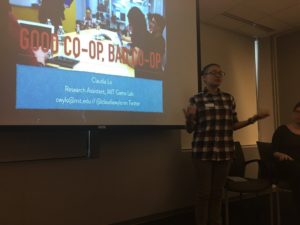Boston FIG Talk: Good Co-op Bad Co-op

On January 8, 2017, the Recasting Player Two crew headed to the Boston Festival of Indie Games to give a FIG Talk on our research on the gendered dynamics of co-operative play. We spoke to a crowded room of developers, games critics, academics and fans about the passive play and spectatorship, the dynamics of playstyles and roles, and new and more inclusive themes for co-operative game design.
The Center/Periphery Problem
The center/periphery model is an unspoken assumption that guides design practices. T he term can be understood in two ways:
he term can be understood in two ways:
- The “center” is the player and the periphery are spectators (or anyone without a controller in their hands); or
- The “center” is player one and the periphery are all other players.
Generally, we assume the person holding the controller is the most important one when it comes to playing the game. And within this, there is another hierarchy where player one is assumed to be the most important, and all others assume a supporting, satellite, or less important role. We wanted to complicate both of these ideas. First, we wanted to understand the distinction between player and spectator as less of a hard boundary and more of a spectrum; and second, we wanted to suggest possibilities for creative game designs that could decentralize co-operative play and create fun roles within that spectrum. What if we could create games where spectation, and less active play was just as important as forms of play where you are operating the controller? Or where that hierarchy between players was flattened?
Playstyles and Roles
It’s tempting to think that the solution to the center/periphery problem would be to give all players the same amount of play time with different roles – and yes, this does put players on a more equal playing field. That being said, we also have to account for problematic dynamics in the way we think of roles – and indeed, certain types of roles are privileged over others.
First, a couple of clarifications. When we say “roles,” we mean different types of play: strategic, exploratory, investigative, reflex-based, and so on. And when we say “privileged,” we mean a few things. Sometimes, certain roles and playstyles aren’t included in games at all. Other times, some roles are more necessary to gameplay than others. Sometimes, some roles are more fun than others, meaning players fight over those roles. And often, some roles are associated implicitly with personality types, genders and other traits, so that social dynamics impact who gets to play which roles. As a result of this privileging, people are excluded, some roles are degraded for the level of skill they supposedly require, and players get stuck in roles they don’t like.
To help tackle this problem, we want to see more games with multiple playstyles in mind, especially playstyles that are currently underserved. We want designers to keep in mind that just because a role has a lower skill cap, doesn’t mean it should be less fun or less necessary to the game – some players want to be integral to winning the game but want a low-skill role, while others want a high-skill role but don’t care about being central to team play. Finally, we want designers to ask while they’re working on character and interaction design: what is the relationship between what the player is doing and how they’re doing it? Which brings us to our final point.
Theming
When we learn game design, we are taught to come up with the core mechanics of a game before draping a theme over it. But in playing, researching and workshopping co-op games, we’ve found that theme plays such a crucial role in the gendered dynamics of co-operative play that we want designers to reconsider that model. Unconventional themes can illuminate new possible roles. For example, during our second workshop, one team designed a collaborative poetry writing game in which players could take on the role of commissioner, writer, editor, proofreader, or recipient. Here, the theme of the game defined it s roles and playstyles, allowing for a unique form of collaboration that would not have emerged if we had thought of the mechanics first.
s roles and playstyles, allowing for a unique form of collaboration that would not have emerged if we had thought of the mechanics first.
To be clear, we are not advocating for a full-scale turnaround in the way we design games – we’re still teaching our students to create core mechanics first. But for experienced designers looking for ways to come up with creative new co-op, this way of designing could be a fruitful alternative.
We’re really happy with the thoughts and ideas that have come out of our two workshops so far. We’re looking forward to hosting more in the future and seeing what we can come up with! Thanks so much to everyone who attended both workshops and to everyone who came out to our FIG Talk.
This post was written by Kaelan Doyle Myerscough with additions from Claudia Lo, and minor edits by Mikael Jakobsson. Photos by Rik Eberhardt. Together we are the Recasting Player Two project team. Funding for this project was provided by ReFiG.
